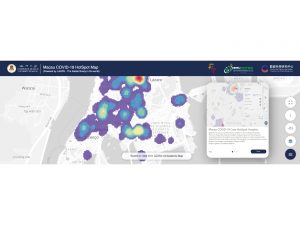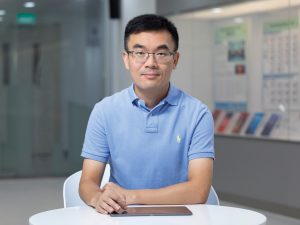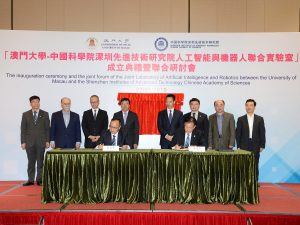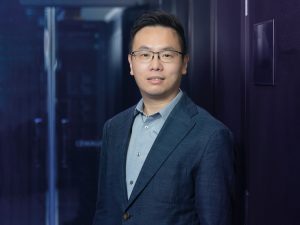The new generation of information technologies, including big data and AI, is the driving force behind smart city development, promoting smart applications in advanced cities around the world. To facilitate such applications, a research group on urban big data and intelligent technology of the State Key Laboratory of Internet of Things for Smart City (SKL-IOTSC) at the University of Macau (UM) conducts fundamental research to design highly-efficient algorithms in order to enhance the computational thinking capabilities of smart cities and extract valuable information to assist decision-makers.
Developing Algorithms to Support Smart City Applications
With the support of big data, intelligent technologies are transforming all aspects of our lives, from government decision-making and services, to the way people live, to industrial layout and urban planning. The research group is committed to solving fundamental scientific problems facing big data analysis and processing by developing mathematical models, principles, and computational methodologies. Through big data analytics, the researchers can extract accurate and useful information to inform decision-making and improve products based on the practical needs of residents in order to develop more human-centred cities.
Computational science is not only an important symbol of China’s competitiveness in science and technology, but also a discipline that UM developed in recent years. The solutions to many major scientific problems rely heavily on fundamental algorithms and computational models. Currently, the researchers are developing a number of high-performance fundamental algorithms and exploring multisource data fusion techniques for smart city development. They have made breakthroughs in creating methods for knowledge graph construction with big data and an intelligent multimedia information processing system based on deep learning.
Building Urban Knowledge Graphs
Knowledge graphs integrate information and data available on the network to make them easier to compute and understand, thereby enabling rapid responses and reasoning. The research group uses data streams that are constantly changing and affecting urban operations to build a dynamic information system. The system can generate knowledge graphs and provide city managers with comprehensive monitoring information.
In July 2022, a team led by U Leong Hou, interim head of the Centre for Data Science and associate professor in SKL-IOTSC, developed the Macau COVID-19 HotSpot Map, an efficient real-time system based on spatiotemporal big data and knowledge graph technology. With the large variety and volume of epidemic data in hand, the group used the laboratory’s urban data platform and knowledge graph technology to analyse spatiotemporal data in relation to the transmission chains of different viral strains. The study shed light on the origin and development of the outbreak in Macao and was one of the group’s major contributions to Macao against COVID-19.
To build an analysis and demonstration system, the research group proposed a hotspot algorithm that could run between 10 to 100 times faster than existing algorithms. However, the time complexity of the analysis made it difficult to achieve real-time responses. The group then developed a series of optimisation algorithms to reduce the search space and computational complexity, and as a result, the system produced almost real-time responses. They have presented the research results at several international data engineering conferences.
Building the Largest Super Intelligent Computing Centre in Macao
UM’s third-generation HPC Cluster (Coral) comprises 130 servers, offering over 4,200 computing units and 37 graphics processing units. It also provides eight high-memory computing nodes that contain a total of 24TB of memory. The laboratory has also established the Super Intelligent Computing Center in Macao, the largest of its kind in the city. Equipped with a management and computing server cluster, cloud computing platform software, high-speed network equipment, a high-capacity storage server, and NVIDIA DGX-2, the centre has the immense computing power to assist researchers in handling massive data streams and trillions of parameters, satisfying the demanding requirements for AI technology. These facilities and equipment significantly increase the computational speed of AI and can effectively meet the needs of smart applications for urban big data analysis and processing.
Image Tampering Detection System
At present, the intensive development of communications infrastructure in smart cities revolves around cloud computing. However, the development has also increased security risks due to the high amount of data shared in the process. To address security loopholes in the dissemination of information on the network, a team led by Zhou Jiantao, associate professor in the Department of Computer and Information Science and SKL-IOTSC, has developed a robust image tampering detection system based on AI algorithms. The system is designed to prove the authenticity of images in the face of ever-evolving anti-forensic techniques.
In 2021, the team proposed a new AI detection algorithm that can locate the forged area of a tampered image within 0.5 seconds. The algorithm stood out from over 1,500 teams at the Security AI Challenger Contest and won the championship in the image forgery track, as well as the third prize in the detection track, and was used by the judicial community to identify tampered images. Furthermore, the team was later invited and sponsored by Alibaba to develop Fake Pictures Crusher, a more powerful detection e-tool, which was made available to the public in 2022. Through industry-academia collaboration, the team strives to address security issues in smart city development.
The rapid development of cloud computing and the widespread use of various data acquisition and storage devices have led to increasing demands for better multimedia technology and social network security. To address key issues in multimedia and social network security, such as social network interference, poor generalisation ability, and low security reliability, the team took the initiative to establish an analysis mechanism for different social media platforms. The researchers developed highly robust multimedia forensic technologies and feature learning algorithms with data privacy protection. The project was awarded a third prize in the natural science category of the Macao Science and Technology Award and has been widely cited and applied by scholars in China and abroad.
Exploring the New Generation of Digital Technology
Building on the strength of the joint laboratory between UM and the Shenzhen Institute of Advanced Technology of the Chinese Academy of Sciences, the research group is constantly exploring the relevance and patterns of large urban datasets and expanding innovative AI research, with a focus on developing the new generation of digital technology. The group’s fundamental algorithmic research will play a key role in supporting smart city applications, such as smart energy, intelligent transportation, and urban public safety and disaster prevention, enabling cities to achieve rational resource allocation and self-regulation.
Text / Kelvin U, Trainee UM Reporter Zhang Jiahe
Photo / Jack Ho, with some provided by the interviewees
English Translation / Winky Kuan
Source: UMagazine ISSUE 27
Related articles:
1. Exploration and innovation: UM State Key Laboratory of Internet of Things for Smart City
2. Supporting smart city development — Intelligent sensing and network communication
3.Creating a low-carbon smart energy system with high efficiency
4. Developing safe and efficient autonomous driving technologies
5. Enhancing structural health monitoring and disaster response capabilities

The Macau COVID-19 HotSpot Map developed by UM integrates spatiotemporal big data and knowledge graph technologies

Prof Zhou Jiantao

The detection e-tool Fake Pictures Crusher

The Joint Laboratory of Artificial Intelligence and Robotics jointly established by UM and the Shenzhen Institute of Advanced Technology of the Chinese Academy of Sciences

Prof U Leong Hou
